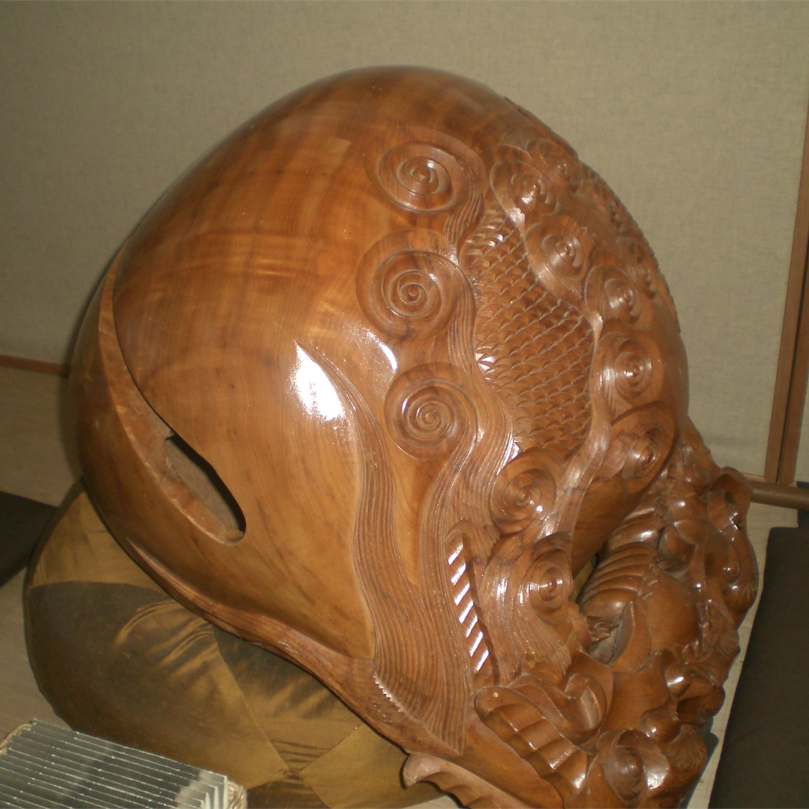muyu overview
 Wooden fish (pinyin: Mùyú) is a kind of wooden percussion instrument. The common fish-shaped wooden fish is shaped like a round sphere close to a fist, and the middle part is hollow, which is used for sound resonance and amplification. There is a sound hole on one side of the sphere, which has the same function as the F-shaped hole of a violin. It allows the amplified sound to spread. on the shelf. The method of playing is to use a drum stick or a small wooden hammer to hit the resonance area on the outside of the instrument to make a sound. The size of the wooden fish can be of different sizes, the larger the volume, the lower the pitch.
Wooden fish (pinyin: Mùyú) is a kind of wooden percussion instrument. The common fish-shaped wooden fish is shaped like a round sphere close to a fist, and the middle part is hollow, which is used for sound resonance and amplification. There is a sound hole on one side of the sphere, which has the same function as the F-shaped hole of a violin. It allows the amplified sound to spread. on the shelf. The method of playing is to use a drum stick or a small wooden hammer to hit the resonance area on the outside of the instrument to make a sound. The size of the wooden fish can be of different sizes, the larger the volume, the lower the pitch.In the period of Emperor Xuanzong of the Tang Dynasty, it was used as a Taoist instrument. According to the Records of Chongdao in the Past Dynasties, Quzhou Jianguan pierced the ground to get a fish that could be three feet long. Jun, it is beyond the capabilities of human power, the knocking is very loud, and the fish cannot be named, even if an envoy is sent to pay tribute, and the emperor decrees a hundred officials, it cannot be distinguished. In addition, the name of "wooden fish" in Buddhism was first seen in the Tang Dynasty Huaihai Chan Master's "Edict Xiu Qinggui": "Wooden fish, according to legend: the fish is always awake day and night, and the carved wooden image strikes it, so the alert is faint and lazy."
The origin of the name of the wooden fish is taken from "fish do not close their eyes day and night", so it is carved to look like a fish, and it is tapped to admonish day and night to think. When reciting the sutras, it cooperates with the bronze chime to control the chanting of the sutras.
In the national band, there are complete sets of wooden fish of different sizes and numbers, which are arranged and combined according to the pentatonic scale, the heptatonic scale or the twelve equal temperament. They are often used in lively and lively music. The effect of imitating the sound of hooves. Muyu is also the percussion instrument of the folk art "Muyu Song" in Guangdong.
Because he did not enter the court music, the official history of the past dynasties is not recorded. Wooden fish is often used to accompany "Brahma" (religious songs) in Buddhism, with a strong religious color. In Ming Dynasty Wang Qi's "Sancai Tuhui" contains: "Wooden fish, carved in the shape of a fish, empty in the middle, and sound when knocked. . Muyu Song and Kunqu Opera accompaniment. In the Qing Dynasty Li Dou's "Yangzhou Painting Boat Lu", there was a wooden fish among the musical instruments used in the theater at that time. Later, it was gradually applied in singing and dancing accompaniment and instrumental ensemble. In addition to being used in Buddhist and Taoist music, wooden fish is also widely used in various forms of instrumental ensembles and bands.
- type:percussion
- origin of the name:It was first seen in
- place of use:Mostly used for Buddhist and Taoist homework and pujas
- pinyin:Mùyú
overview of other similar instruments
- sanyanxiao overview
- Daguangxian overview
- Leiqin overview
- hahao overview
- yandundagu overview
- Han Xiaozheng overview
- Fang Xiang overview
- guanzi overview
- zhuqin (Dao Qin) overview
- zhuiqin overview
- bangzi overview
- three-stringed piano overview
- Gehu overview
- xiao overview
- xiaokonghou overview
- Konghou overview
- Sheng overview
- suona overview
- hulusi overview
- gushao overview
 渝公网安备 50010702504639号
渝公网安备 50010702504639号